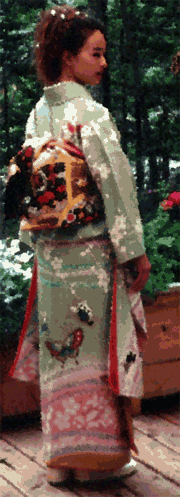|
|
|
About KimonoMost kimono are of a uniform shape and size, and are constructed in such a way that one size really does fit all. Kimono are composed of rectangular panels of fabric that are sewn together. This panel design allows it to be neatly folded. Kimono can also be disassembled, cleaned, and then reassembled thanks to this design.The standard kimono pattern includes the following parts:

Length: 158 cm Sleeve and shoulder width: 63 cm Sleeve width: 32 cm Shoulder width: 31 cm Sleeve depth: 49 cm There is some variation on these dimensions, as you can see in our measurements of the kimonos that we have for sale. Kimonos can be made of silk, wool, cotton, linen, or synthetic fabrics. Patterns can be produced by weaving, hand painting, embroidery, or use of stencils. Today, weaving by machine is much more common than weaving by hand. If a kimono is dyed before the weaving process, it is categorized as a sakizome kimono. Sakizome kimonos, also known as woven kimonos, include meisen or habutae (reeled silk), omeshi (heavy crepe), tsumugi (spun silk), sha (silk gauze), and ro (leno weave gauze), kasuri (splash pattern), shima (stripe pattern), koushi (checks or lattice pattern), and joufu (linen). If a kimono is dyed after weaving, it is categorized as an atozome kimono. Atozome kimonos, also known as dyed kimonos, include garazome (dyed designs on white fabric), tegakizome (hand-painted), rouketsu (yuzen, batik), katazome (stencil), kata yuzen (hand-drawn yuzen), kata komon (small stencil designs), edo komon (small one-color crests), bingata (multicolor dyeing on stencil resist), chuugata (medium stencils for yukata), kasurizome (tie-dye), and mujizome (pattern-less, one-color dyeing). The main types of formal kimono are:
|
|
|